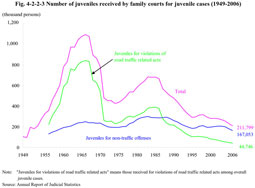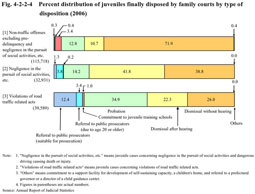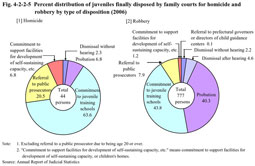| Previous Next Index Image Index Year Selection | |
|
|
2 Juvenile hearing
(1) Juveniles newly received by family courts
Fig. 4-2-2-3 shows the trends in the number of juvenile offenders newly received by family courts since 1949. The number of juvenile offenders received for non-traffic offenses hit a peak in 1966 and 1983, and then it was on a declining trend for a while. In recent years it had been flat at around 200,000 juveniles, but the number decreased slightly in 2005 and 2006. In contrast, the number of juvenile offenders received for violations of road traffic related acts declined sharply after the traffic violation notification system came to be applied to juveniles in 1970 and the range of application of the system was expanded in 1987, and has been on a declining trend ever since. Fig. 4-2-2-3 Number of juveniles received by family courts for juvenile cases (1949-2006) (2) Disposition of juvenile cases a. Outline of final disposition Fig. 4-2-2-4 shows the percent distribution of juveniles finally disposed by family courts for [1] non-traffic offenses excluding pre-delinquency and negligence in the pursuit of social activities, etc., [2] negligence in the pursuit of social activities, etc., and [3] violations of road traffic related acts in 2006, by type of disposition. Fig. 4-2-2-4 Percent distribution of juveniles finally disposed by family courts by type of disposition (2006) b. Disposition for homicide and robbery Fig. 4-2-2-5 shows the percent distribution of juveniles finally disposed by family courts for homicide and robbery, by type of disposition (see Appendix 4-10 for the number of juveniles finally disposed by family courts in juvenile cases, by type of offense). Fig. 4-2-2-5 Percent distribution of juveniles finally disposed by family courts for homicide and robbery by type of disposition (2006) c. Referral to public prosecutors for prosecution Table 4-2-2-6 shows the number of juveniles finally disposed by family courts for cases where juveniles aged 16 or over killed victims through an intentional criminal act (hereinafter referred to as “cases of juveniles aged 16 or over to be referred to public prosecutors for prosecution in principle” in this section) (excluding those referred to public prosecutors due to being age 20 or over; hereinafter the same in this section), by type of offense over the past five years. The total number of juveniles in cases to be referred to public prosecutors for prosecution in principle was 324 (excluding 12 juveniles who were referred to public prosecutors and then transferred from district courts under Article 55 of the Juvenile Act back to family courts), amongst whom 193 (59.6%) were decided to be referred to the public prosecutor. Looking at the percent rate of juveniles who were referred to public prosecutors (suitable for prosecution) among finally disposed juveniles by type of offense, homicide (consummation) accounted for 54.1%, injury causing death for 52.9%, dangerous driving causing death for 93.9%, and robbery causing death for 71.7%. All of the 12 juveniles mentioned above (10 juveniles for injury causing death, and 2 juveniles for robbery causing death) who were transferred from district courts to family courts were committed to juvenile training schools (Source: The General Secretariat of the Supreme Court). Table 4-2-2-6 Number of juveniles finally disposed by family courts for cases of juveniles aged 16 or over to be referred to public prosecutors for prosecution in principle, by type of offense (2002-2006) |



